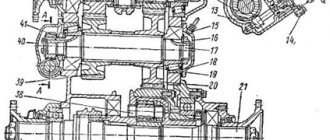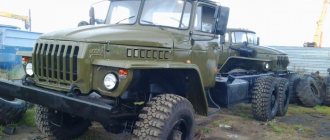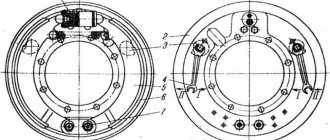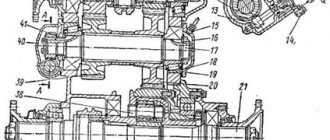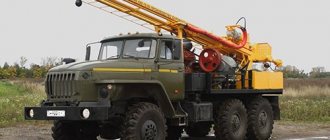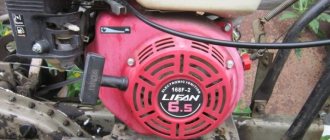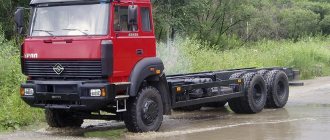Family "Susha" (Ural-4322/5323) (1978 - 1993)
Family "Susha" (Ural-4322/5323)
(1978 – 1993)
The promising family of air-transportable trucks "Susha" was created by the Ural Plant since April 1977, taking into account the experience of operating serial three-axle vehicles and the development of the first experimental generation 379/395, including their unique amphibious variants. With the commissioning of the Kama Automobile Plant and its engine production, initially the Susha range was optimistically supposed to be equipped with the entire series of unified V-shaped diesel and multi-fuel KamAZ engines with the same cylinder diameter and piston stroke (120 mm each) and the number of cylinders 6, 8 or 10, as well as transmission and chassis components produced by YaMZ. The realities turned out to be not so optimistic: KamAZ was able to establish mass production of only one 8-cylinder diesel engine, which was subsequently equipped with all KamAZ vehicles and army Ural-4320.
In 1978, the plant assembled the first basic three-axle bonneted vehicle "Ural-4322" (6x6) of the "Susha" family with a lifting capacity of 5.5 tons (later with a winch - 5.0 tons), created on the basis of the serial truck "Ural-4320" » with a wheelbase of 3525+1400 mm and a new all-metal cargo platform 4500 mm long. The long-wheelbase version 4322B with a payload of 5.5 - 6.0 tons and a distance between the centers of the front and middle axles of 3800 mm was made on the 4320 chassis extended by 275 mm. Externally, these cars differed from the serial production by new cabins, tail surfaces and front facing with vertical welded radiator grille. Like the most common Ural-4320, they were equipped with a KamAZ-740.10 diesel engine, V8 (10.85 l, 210 hp), a double-disc clutch, a 5-speed gearbox, an internal pressure regulation system in 20-inch tires, 24-volt electrical equipment, two fuel tanks with a total capacity of 259 liters and a high air intake pipe on the right side of the cab. At the same time, a pneumatic amplifier appeared in the gearbox control system, the traction force of the winch was 6 - 8 tf (depending on the sequence of turns), and additional sealing of the main units and the cabin made it possible to increase the fording depth to 1.75 m. Increasing the wheelbase of the model 4322B led to the installation of a new all-metal cargo platform 4694 mm long with an awning that could accommodate up to 33 troops. At the same time, the increase in the overall length of trucks to 8050 mm had virtually no effect on cross-country ability. The curb weight of the 4322 cars reached 9050 kg, the gross weight was 14,850 kg, the maximum speed was 85 km/h, and the range was 840 km. They could tow trailers weighing from 7.0 to 11.5 tons on roads with different surfaces. In the same 1978, the first experimental three-axle cabover truck 4322A with a modified cab from KamAZ and a hooded truck tractor 4422 were built. Later, a second one appeared in this series tractor 44221 with a power take-off, designed to work with the active semi-trailer "Ural-862", and multi-purpose short-wheelbase chassis 43224 with an installation frame length of 4461 mm.
Basic 5.5-ton army truck "Ural-4322" with a 210-horsepower KamAZ V8 diesel engine. 1978
A prototype of the Ural-4322A cabover truck with a cab from KamAZ vehicles. 1978
Simultaneously with the three-axle vehicles, two prototypes of the Ural-5322 (8×8) cabover tractor-trailer with a lifting capacity of 8.5 - 9.0 tons were assembled. It was created as a modernized version of the first four-axle vehicle "Ural-395" with the expectation of using a more powerful 10-cylinder diesel engine, which was supposed to be mass-produced at the engine department of the Kama plant. The vehicle was equipped with a tilting steel cab, which in terms of external panels and internal equipment was unified with the cab of KamAZ trucks, but was distinguished by a modified front facing. The main design feature was the experimental KamAZ-741 V10 engine with a power of 260 hp, generally identical to the YaMZ-741 model and assembled in several test copies at KamAZ. The prototypes were equipped with a 5-speed gearbox and a two-speed transfer case, a balanced spring suspension, a winch, a tire pressure regulation system and a metal cargo platform with an awning. They had a curb weight of 10.8 tons, towed trailers with a total weight of up to 10 tons and reached speeds of 80 km/h on the highway. Insoluble problems with putting into mass production the complex, heavy and less economical V10 engine put an end to the fate of the original car, which was soon replaced by the updated 5323 range with a V8 engine.
The most interesting cars in the first range of the “Sushi” family in 1978 were also secret trucks, adapted to overcome deep water obstacles afloat and which became a development of the 379/395 series cars. Externally, they also hardly differed from ordinary land vehicles, although they were distinguished by high, sealed all-metal bodies that provided buoyancy, and removable front water-reflecting shields. Two propellers were located under the rear of the cargo platform and received torque from the vehicle's power take-off. In the three-axle floating series there was an experimental 4-ton vehicle 43221A (4322P) with a winch, a sunroof and two fuel tanks, capable of moving on the highway at the speed of conventional trucks (85 km/h) and having a cruising range on land of 1040 km. To prevent water from entering the engine compartment, a special shield with an internal air duct for cooling the radiator was installed in front of the radiator. At the same time, a 7-ton floating version 53221 (5322P) with a power reserve of 1000 km was created on chassis 5322. On the water, a truck converted in this way without floats was immersed in the water to the level of the hood and moved by propellers and rotation of all wheels.
A prototype of the Ural-5322 (8x8) car with a promising KamAZ V10 diesel engine. 1984
Modernized 4-ton amphibian "Ural-43221A" with two propellers. 1979
In September 1979, experimental vehicles of the “Susha” family arrived at testing ground 21 of the Research Institute for testing on land and in its own reservoir, then traveled over 30 thousand km along public roads and desert regions of the Turkmen SSR, and the amphibians also underwent factory testing on Lake Turgoyak Chelyabinsk region. Based on their results, in 1980, cars of almost all types received recommendations for adoption and mass production. The exception was the land version 5322, although its testing and development continued until 1984.
By the mid-1970s, about 10 thousand German Magirus-Deutz trucks with air-cooled engines, purchased in 1974 under the “contract of the century,” were working on the construction of the Baikal-Amur Railway (BAM). Such power units proved themselves to be excellent in the eastern regions of the USSR; they were simpler, lighter and cheaper than liquid-cooled diesel engines and could operate smoothly in extreme temperature conditions. In the wake of the enormous success of the Magirus, in 1982 they purchased a license for the F8L413 V8 diesel engine (11.3 liters, 232 hp), developed back in 1969, and then formed a joint venture to assemble it in the USSR. On the initiative of chief designer A. A. Romanchenko, they decided to establish serial production of engines at the Kustanai Diesel Plant (KDZ) of the Kazakh SSR, which had been built since 1981 with a production capacity of 40 thousand engines per year, which was then part of the UralAZ Production Association. In 1986 - 1987, prototypes of the Ural-744.10 air-cooled V8 engines with a power of 234 hp were assembled at a still unfinished enterprise. This made it possible in 1987 to introduce a new long-wheelbase 6-ton multi-purpose hooded truck 43223 with a wheelbase of 3800+1400 mm, which became a continuation of the Susha family. The first editions had a narrowed welded radiator grille; subsequent production cars had a new stamped lining. Externally, the car was distinguished by a high air intake pipe of the cooling system on the left side of the cabin, equipped with an autonomous heater and a sprung, adjustable driver's seat. It had an all-metal 4.7-meter side platform with short wheel wells and a flat floor, as well as a modernized 8-ton winch with a cable output forward and backward. On the highway, the truck reached a speed of 93 km/h; on various types of roads and terrain it could tow trailers weighing 10.0 - 11.5 tons. Average fuel consumption was 34 liters per 100 km. In addition, long-wheelbase 5.5-ton chassis 43222 were created for mounting standard habitable bodies K-4322, version 43225 for installing army superstructures and bodies K2.4320, as well as civilian dump trucks 55223 and 55224 with a carrying capacity of 7.2 and 10 tons.
In 1990, small-scale production of engines finally began at KDZ, and in June 1992, the Ural Automobile Plant began industrial production of the main models of trucks and chassis of the 4322 series with KamAZ-740 and Ural-744 engines. In the same year, the joint venture with, which remained on the territory of independent Kazakhstan, collapsed and stopped producing power units. In three years, KDZ was able to assemble only 405 engines, so we can assume that the number of complete 4322 series trucks was slightly less. One of the last vehicles in this range in 1993 was the civilian short-wheelbase three-axle truck tractor 44223 (wheelbase 3525+1400 mm) with an extended cabin and rear gable wheels, which was supposed to be used in conjunction with the Ural-9516 semi-trailer with a load capacity of 13.5 - 15 ,0 t. A relatively small number of Ural-4322 vehicles that entered service with the troops were withdrawn from service in September 1998.
Multi-purpose truck "Ural-43223" with an air-cooled diesel engine. 1987
A promising car "Ural-5323" with a 260-horsepower KamAZ V8 engine. 1989
In the 1980s, the development of the first four-axle vehicle 5322 became the 9-ton truck 5323 of the Susha family, equipped with a new 260-horsepower KamAZ-7403.10 V8 turbocharged diesel engine, a 5-speed gearbox, its own two-speed transfer case and a winch. Increased cross-country ability and smooth running were ensured by balanced spring suspensions of the front steered wheels with hydraulic shock absorbers and the rear drive bogie. Its cabin was also unified with KamAZ vehicles, equipped with an effective ventilation system, a heater and an adjustable driver's seat, but outwardly differed in a number of front facing elements. The weight of the towed trailer on roads of all categories and on terrain was 10 tons, the maximum speed was 88 km/h, and the range was up to 1000 km. Work and testing of the 5323 continued until the end of the 1980s and led to the release of the first trial batch in 1989. Serial production of this range began already in the 1990s, but these were already significantly modernized vehicles with a new power unit. After a devastating fire in the engine department of KamAZ, which broke out on the night of April 14-15, 1993, the plant hastily refocused on the new 300-horsepower YaMZ-238B V8 diesel engine, which began to be installed on modernized vehicles 532301 and 532302 with different cabs.
So, at about the same time, the end was put to the use of both licensed Deutz engines and KamAZ engines in military “Urals”, which led to a stop in work on the promising army “Susha” family. Subsequently, it was replaced by a new generation of Motovoz vehicles, which included two-, three- and four-axle army trucks with YaMZ engines and transmissions.
Engine
The Ural 4320 was equipped with various types of power plants:
- KamAZ-740;
- YaMZ-236;
- YaMZ-238;
- YaMZ-6565;
- YaMZ-536.
KamAZ-740 has long been considered the basic unit of the series. The V-shaped “eight” provided excellent traction and was highly reliable. The engine design had much in common with the products of the Yaroslavl Motor Plant, but there were a number of obvious differences. Thus, each KamAZ-740 cylinder was equipped with a separate block head.
Characteristics of the KamAZ-740 engine:
- working volume – 10.86 l;
- rated speed – 2600 rpm;
- rated power – 154 (210) kW (hp);
- maximum torque – 650 Nm;
- compression ratio – 17.
Diesels YaMZ-236 and YaMZ-238 replaced the KamAZ-740 engine after a fire at the Kama Automobile Plant. Structurally, the engines had much in common, but the main difference was the number of cylinders.
YaMZ-236 was considered the founder of a series of V-shaped engines from the Yaroslavl plant. The unit was produced in Euro-1 and Euro-2 versions. The 4-stroke engine had direct fuel injection and a water cooling system.
Characteristics of the YaMZ-236 engine:
- working volume – 11.15 l;
- rated speed – 2100 rpm;
- rated power – 169 (230) kW (hp);
- maximum torque – 882 Nm;
- number of cylinders – 6;
- compression ratio – 16.5.
The YaMZ 238 diesel engine was installed on more powerful versions. It was characterized by compression ignition, liquid cooling and direct injection (available in turbocharged and non-turbocharged versions).
Unit characteristics:
- working volume – 14.86 l;
- rated speed – 2100 rpm;
- rated power – 176 (240) kW (hp);
- maximum torque – 883 Nm;
- number of cylinders – 8;
- compression ratio – 16.5.
The YaMZ-6565 and YaMZ 536 motors were included in the engine line due to stricter environmental standards.
The YaMZ-6565 unit is part of the family of V-shaped 6-cylinder diesel engines of the Yaroslavl plant. The engine has a turbocharger, a liquid-oil heat exchanger, intermediate air cooling, water cooling and direct fuel injection. The engine complies with the Euro-4 environmental class.
Characteristics of the YaMZ-6565 unit:
- working volume – 11.15 l;
- rated speed – 1900 rpm;
- rated power - 220.6 (300) kW (hp);
- maximum torque – 1275 Nm;
- compression ratio - 17.5.
The YaMZ-536 engine belongs to the 530th family of engines and is a basic “six” with an in-line cylinder arrangement, a turbine and liquid cooling. To ensure Euro 4 compliance, the unit uses a catalytic converter and an exhaust gas recirculation (EGR) system.
Characteristics of the YaMZ-536 engine:
- working volume – 6.65 l;
- rated speed – 2300 rpm;
- rated power – 229 (312) kW (hp);
- maximum torque – 1226 Nm;
- service life – 1,000,000 km.
Device
Chassis
The Ural 4320 has high cross-country ability, which was achieved due to the 6 by 6 wheel arrangement and single-pitch wheels, supplemented by automatic adjustment of filling the chambers with air. The front part uses a dependent suspension mounted on semi-elliptical springs with sliding rear ends and double-acting shock absorbers. The rear part also uses a dependent balancer suspension with springs with reaction bars. All axles of the car are driving.
Base wheel parameters:
- type – disk with fastening on 10 studs;
- rim - 330-533 or 254G-508;
- tire type – tube pneumatic.
The riveted frame of the Ural 4320 consists of 2 stamped spars, united by cross members (ladder type).

